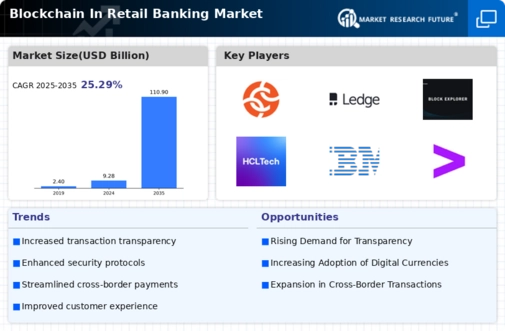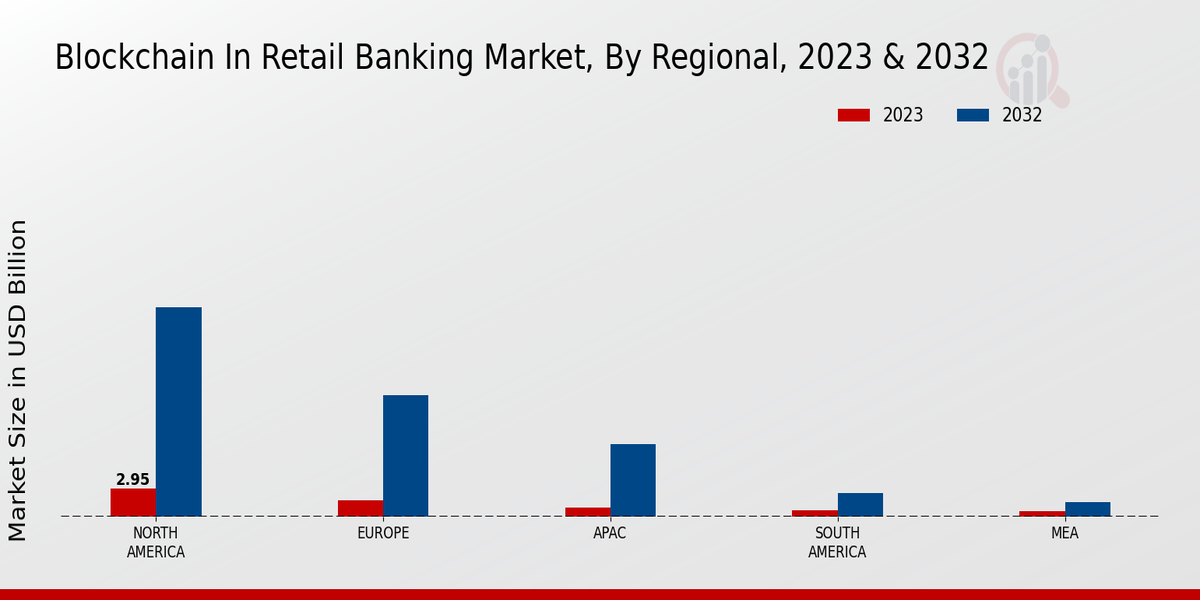Market Growth Projections
The Global Blockchain In Retail Banking Market Industry is poised for substantial growth, with projections indicating a rise from 9.28 USD Billion in 2024 to 110.9 USD Billion by 2035. This remarkable expansion reflects a compound annual growth rate of 25.3% from 2025 to 2035, highlighting the increasing integration of blockchain technology in retail banking. The anticipated growth is driven by various factors, including enhanced security, operational efficiency, and regulatory support. As financial institutions continue to explore innovative solutions, the market is likely to witness significant advancements, positioning blockchain as a transformative force in the banking sector.
Enhanced Security Features
Security remains a paramount concern in the Global Blockchain In Retail Banking Market Industry. Blockchain technology offers robust security features through its decentralized nature and cryptographic algorithms, which significantly reduce the risk of data breaches and unauthorized access. Financial institutions are increasingly investing in blockchain solutions to safeguard sensitive customer information and transaction data. This focus on security is expected to contribute to the market's growth, as the industry anticipates a surge in demand for secure banking solutions. By 2035, the market could expand to 110.9 USD Billion, driven by the need for enhanced security measures.
Increased Demand for Transparency
The Global Blockchain In Retail Banking Market Industry experiences heightened demand for transparency in financial transactions. Blockchain technology facilitates real-time tracking and verification of transactions, which enhances trust among consumers and financial institutions. This transparency is particularly crucial in combating fraud and ensuring compliance with regulatory requirements. As a result, banks are increasingly adopting blockchain solutions to provide customers with a clear view of their transaction histories. The growing emphasis on transparency is likely to drive the market, as it is projected to reach 9.28 USD Billion in 2024, reflecting a shift towards more accountable banking practices.
Cost Efficiency and Operational Streamlining
The Global Blockchain In Retail Banking Market Industry is witnessing a shift towards cost efficiency and operational streamlining. Blockchain technology enables banks to automate various processes, reducing the need for intermediaries and minimizing transaction costs. This efficiency not only lowers operational expenses but also accelerates transaction speeds, enhancing customer satisfaction. As banks seek to optimize their operations, the adoption of blockchain solutions is likely to increase. The anticipated compound annual growth rate of 25.3% from 2025 to 2035 underscores the potential for significant cost savings and improved operational efficiency within the industry.
Regulatory Support and Framework Development
Regulatory support plays a crucial role in the evolution of the Global Blockchain In Retail Banking Market Industry. Governments and regulatory bodies are increasingly recognizing the potential of blockchain technology to enhance financial systems. As a result, there is a growing trend towards developing regulatory frameworks that facilitate the safe and effective implementation of blockchain solutions in banking. This supportive environment encourages financial institutions to invest in blockchain technology, fostering innovation and growth. The establishment of clear regulations is likely to contribute to the market's expansion, as banks navigate compliance while leveraging blockchain's benefits.
Growing Consumer Adoption of Digital Banking Solutions
The Global Blockchain In Retail Banking Market Industry is significantly influenced by the growing consumer adoption of digital banking solutions. As customers increasingly prefer online and mobile banking services, financial institutions are compelled to enhance their digital offerings. Blockchain technology provides the necessary infrastructure to support secure and efficient digital transactions, thereby meeting consumer expectations. This trend is likely to drive the adoption of blockchain solutions in retail banking, as institutions strive to remain competitive in a rapidly evolving digital landscape. The market's growth trajectory suggests a robust future, with increasing consumer demand shaping the industry's direction.























